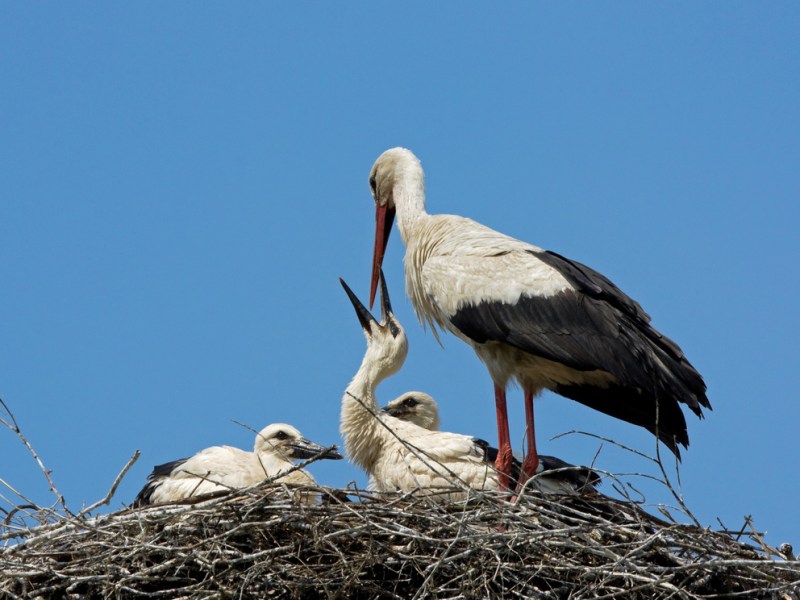
Storks
Ever since we moved to this region, we have been able to enjoy a beautiful stork pair every year, making their nest in Prečna, a village just before Novo mesto. From about mid-April to the end of August, each time we drive past it, we can follow how they repair their nest, forage for food, and later raise their young until they set out on their own. Usually, they have 3 to 4 youngsters per year because a stork only has a nest once a year and lay an average of 3 to 5 eggs. This year, however, they only had one chick.

Last year we suddenly saw a new young couple building their first nest, about 6 kilometers before the »old« pair. So from then on, we could follow two families :). Last year, however, the new couple was not successful, they did not have a young. But this year it was a hit. Bine and I even saw them both busy “practicing” once, hahaha. Their fierce efforts paid off because this year they had 3 chicks!
I think they are such beautiful animals and I really feel privileged that we can see them every year for all those months. They regularly walk in a field along the road, looking for frogs and other “goodies”. There are many more of them in the area. That became clear in the spring when we drove to Novo mesto one day and we suddenly saw a whole muster of storks flying around. They all flew in circles, but close to each other. There were at least 30 of them. So cool! Years ago, when we still lived in Predoslje, we saw a whole bunch flying over our house. A beautiful sight!

There are about 200 pairs of storks in Slovenia. Storks are migratory birds that winter in Africa. They leave at the end of August and in the second half of April, they return to their nest. According to a news article published last year, Slovenian researchers provided three storks with tracking equipment in 2015 and 2016. That way the researchers were able to see that the birds’ journey went across the Balkans and that they crossed the Bosporus in Turkey. Then they flew over Siria and Israel to Africa. Once there, they flew on over Egypt and Sudan. Two storks spent the winter somewhere between Ethiopia, Kenya, and Tanzania, the third one in Chad. At that time they had covered a distance of no less than 7000 kilometers.
The storks have a biological clock that tells them when it is time to leave. Their departure may be delayed due to weather conditions. Heavy rainfall or storms can hold back birds for a long time and unfortunately also kill many of them.
The spring migration of storks is twice as fast as the migration back to Africa in the autumn. This is because the birds are in a hurry to get to their nest in the spring. They fly an average of 200 kilometers a day, but they can also fly a lot more. The first to return to the nest is the male, about a week later the female follows. Nowadays it is also increasingly common that they just hibernate here. They can withstand the cold but must have enough to eat. When there is no snow, they hunt mice. The chance that they survive the winter here is much higher than the chance that they survive the migration. Many birds die along the way due to illegal hunting, severe storms, or high voltage cables. Such changes are also observed elsewhere in Europe. The Spanish stork population regularly migrated across Gibraltar to Africa, but nowadays they often remain in Spain over the winter and find their food on, for example, rubbish dumps.
What I find striking is that the white stork only nests in populated areas. I don’t know why, but it is interesting. A few years ago, the municipality placed some poles near Prečna for the storks where they could build their nests. However, the posts were placed in a field way outside the village. They are still there, but without nests. You always see the nests between houses or on a busy road. There is even a nest on a sign pole over the highway! Perhaps storks have bad hearing and are therefore not bothered by the noise :)?

In the meantime »our« storks have left for Africa again, together with their children. I sincerely hope that they will arrive safely and that we can welcome them back to our country next April. Have a safe trip, guys!
No Comment